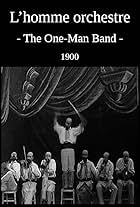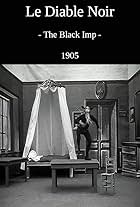A Japanese magician and two boys bring to life a silkscreen of a woman. The woman then gets on a pedestal and the man wraps her in paper. He sets fire to the paper, and she disappears. He ju... Read allA Japanese magician and two boys bring to life a silkscreen of a woman. The woman then gets on a pedestal and the man wraps her in paper. He sets fire to the paper, and she disappears. He jumps in the fire and also disappears. Five women materialize with umbrellas. They disappear... Read allA Japanese magician and two boys bring to life a silkscreen of a woman. The woman then gets on a pedestal and the man wraps her in paper. He sets fire to the paper, and she disappears. He jumps in the fire and also disappears. Five women materialize with umbrellas. They disappear, and the umbrellas float up and disappear. The magician and the woman reappear. They tear... Read all
- Director
Featured reviews
In this film, a 'Japanese' man appears along with two 'Japanese' kids and a 'Japanese' lady. They dance about, he performs some nice magic (including some fire) and it has some innovative spinning umbrellas. Following this, you get to see some butterflies appear--but they are REALLY Lame, as you can see the stagehands dressed all in black (like magicians' hidden assistants) manipulating the fake butterflies. Then, he and two female assistants draw leaves and a caterpillar with chalk and then it becomes real (thanks to the director stopping the camera and inserting the prop caterpillar). Then, using a dissolve it becomes a cocoon and then a giant butterfly. A HUGE amount of the final portion consists of the insect vibrating its wings as colors appear (they were hand-painted on the film stock using stencils) and finally, it becomes a woman butterfly.
While some of the effects were quite nice for 1908, the execution was inconsistent. And, ultimately, the film seemed to drag a bit towards the end. Well done overall but not one of the director's best.
However, it lacks one major thing that Melies gave his films: a love of performance. Melies performed in these films, and his stage craft and vivacity helped to make them far more exciting than his competitors' efforts. The result here is good, very good indeed, but it's not a patch on Melies.
However, just how much were these films being watched anymore? Why was the Spaniard trying to outdo something that was already quite old by this point? Only God knows. Chomón had entered the filmmaking business altogether too late to be of any huge significance, and he has largely been forgotten because of this. Audiences had gotten tired of gimmicks and were looking for more stories in films; by 1908 trick films like this were an outdated fad no one cared to invest in. While Chomón indeed had some unrecognized importance in how he brought these magic films up to date by incorporating closeups and stop-motion animation, this film surprisingly shows nearly none of that more innovative style that he was pioneering the same year. Thus, while this short has some good illusions and lovely stencil-coloring, it's safe to say that because of the most stagy feel to it, "Japanese Butterflies" was probably not a huge success.
The film, as another reviewer has pointed out, uses a motif of the director's which appeared in several other shorts from around that time: Oriental folk, particularly Japanese/Chinese. In it, a magician makes an assistant of his appear before wrapping her in tarp and setting her on fire--a trick seen in Chomón's film "The Red Specter" from the year before. A variety of other gimmicks also occur, such as some floating umbrellas and, predictably, butterflies. The highlight that makes the film is the end, where the director does bring it slightly up-to-date by cutting to a medium closeup to show a caterpillar being drawn on the chalkboard, which climbs in a cocoon and transforms into a butterfly. The color of the film is especially exercised at the end, where said butterfly changes colors, transforms into an actress with butterfly wings, and finally a serpentine dancer performing--which brings back some nostalgia for the popular dance movies of the 1890s.
The ending is apparently missing, since according to the Moving Picture World Synopsis it originally ended showing butterflies rising to Heaven. On top of that, there appears to have been more setup at the beginning of the film that's also unavailable, since the short begins right in the middle of some action. (I have no way of evidencing this claim). Watchable and entertaining but not among the best of Chomón's output.
Details
- Release date
- Country of origin
- Languages
- Also known as
- Las mariposas japonesas
- Production company
- See more company credits at IMDbPro
Contribute to this page














